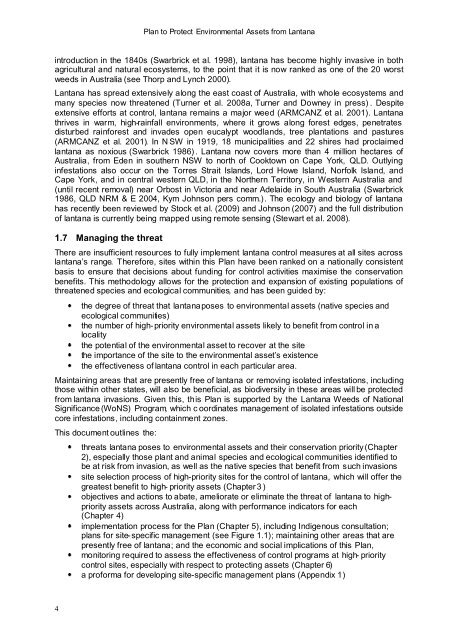Plan to Protect Environmental Assets from Lantana - Weeds Australia
Plan to Protect Environmental Assets from Lantana - Weeds Australia
Plan to Protect Environmental Assets from Lantana - Weeds Australia
Create successful ePaper yourself
Turn your PDF publications into a flip-book with our unique Google optimized e-Paper software.
<strong>Plan</strong> <strong>to</strong> <strong>Protect</strong> <strong>Environmental</strong> <strong>Assets</strong> <strong>from</strong> <strong>Lantana</strong><br />
introduction in the 1840s (Swarbrick et al. 1998), lantana has become highly invasive in both<br />
agricultural and natural ecosystems, <strong>to</strong> the point that it is now ranked as one of the 20 worst<br />
weeds in <strong>Australia</strong> (see Thorp and Lynch 2000).<br />
<strong>Lantana</strong> has spread extensively along the east coast of <strong>Australia</strong>, with whole ecosystems and<br />
many species now threatened (Turner et al. 2008a, Turner and Downey in press) . Despite<br />
extensive efforts at control, lantana remains a major weed (ARMCANZ et al. 2001). <strong>Lantana</strong><br />
thrives in warm, high-rainfall environments, where it grows along forest edges, penetrates<br />
disturbed rainforest and invades open eucalypt woodlands, tree plantations and pastures<br />
(ARMCANZ et al. 2001). In N SW in 1919, 18 municipalities and 22 shires had proclaimed<br />
lantana as noxious (Swarbrick 1986). <strong>Lantana</strong> now covers more than 4 million hectares of<br />
<strong>Australia</strong>, <strong>from</strong> Eden in southern NSW <strong>to</strong> north of Cook<strong>to</strong>wn on Cape York, QLD. Outlying<br />
infestations also occur on the Torres Strait Islands, Lord Howe Island, Norfolk Island, and<br />
Cape York, and in central western QLD, in the Northern Terri<strong>to</strong>ry, in Western <strong>Australia</strong> and<br />
(until recent removal) near Orbost in Vic<strong>to</strong>ria and near Adelaide in South <strong>Australia</strong> (Swarbrick<br />
1986, QLD NRM & E 2004, Kym Johnson pers comm.). The ecology and biology of lantana<br />
has recently been reviewed by S<strong>to</strong>ck et al. (2009) and Johnson (2007) and the full distribution<br />
of lantana is currently being mapped using remote sensing (Stewart et al. 2008).<br />
1.7 Managing the threat<br />
There are insufficient resources <strong>to</strong> fully implement lantana control measures at all sites across<br />
lantana’s range. Therefore, sites within this <strong>Plan</strong> have been ranked on a nationally consistent<br />
basis <strong>to</strong> ensure that decisions about funding for control activities maximise the conservation<br />
benefits. This methodology allows for the protection and expansion of existing populations of<br />
threatened species and ecological communities, and has been guided by:<br />
the degree of threat that lantanaposes <strong>to</strong> environmental assets (native species and<br />
ecological communities)<br />
the number of high-priority environmental assets likely <strong>to</strong> benefit <strong>from</strong> control in a<br />
locality<br />
the potential of the environmental asset <strong>to</strong> recover at the site<br />
the importance of the site <strong>to</strong> the environmental asset’s existence<br />
the effectiveness of lantana control in each particular area.<br />
Maintaining areas that are presently free of lantana or removing isolated infestations, including<br />
those within other states, will also be beneficial, as biodiversity in these areas will be protected<br />
<strong>from</strong> lantana invasions. Given this, this <strong>Plan</strong> is supported by the <strong>Lantana</strong> <strong>Weeds</strong> of National<br />
Significance (WoNS) Program, which c oordinates management of isolated infestations outside<br />
core infestations, including containment zones.<br />
This document outlines the:<br />
threats lantana poses <strong>to</strong> environmental assets and their conservation priority(Chapter<br />
2), especially those plant and animal species and ecological communities identified <strong>to</strong><br />
be at risk <strong>from</strong> invasion, as well as the native species that benefit <strong>from</strong> such invasions<br />
site selection process of high-priority sites for the control of lantana, which will offer the<br />
greatest benefit <strong>to</strong> high- priority assets (Chapter3 )<br />
objectives and actions <strong>to</strong> abate, ameliorate or eliminate the threat of lantana <strong>to</strong> highpriority<br />
assets across <strong>Australia</strong>, along with performance indica<strong>to</strong>rs for each<br />
(Chapter 4)<br />
implementation process for the <strong>Plan</strong> (Chapter 5), including Indigenous consultation;<br />
plans for site-specific management (see Figure 1.1); maintaining other areas that are<br />
presently free of lantana; and the economic and social implications of this <strong>Plan</strong>,<br />
moni<strong>to</strong>ring required <strong>to</strong> assess the effectiveness of control programs at high- priority<br />
control sites, especially with respect <strong>to</strong> protecting assets (Chapter 6)<br />
a proforma for developing site-specific management plans (Appendix 1)<br />
4

















